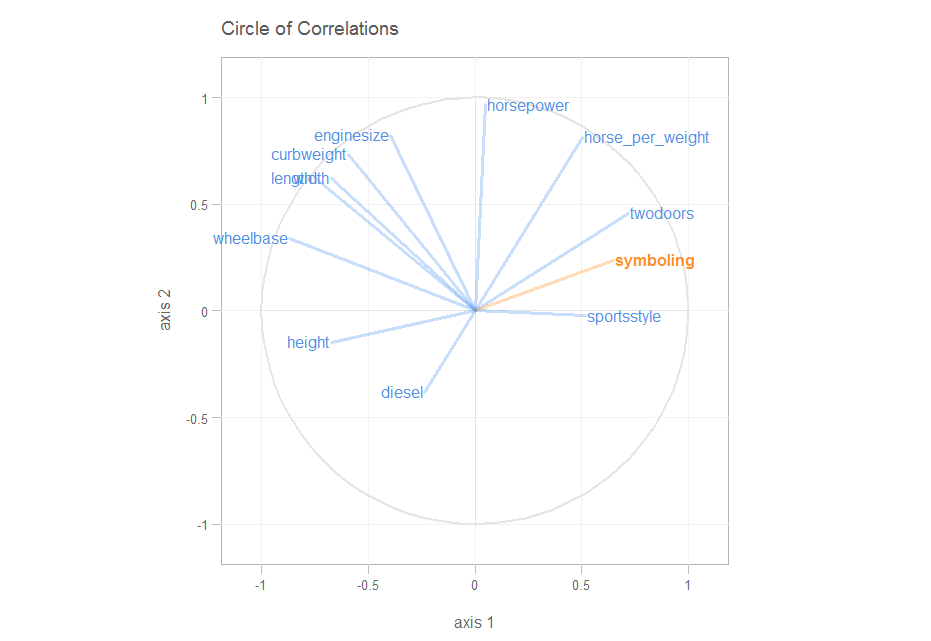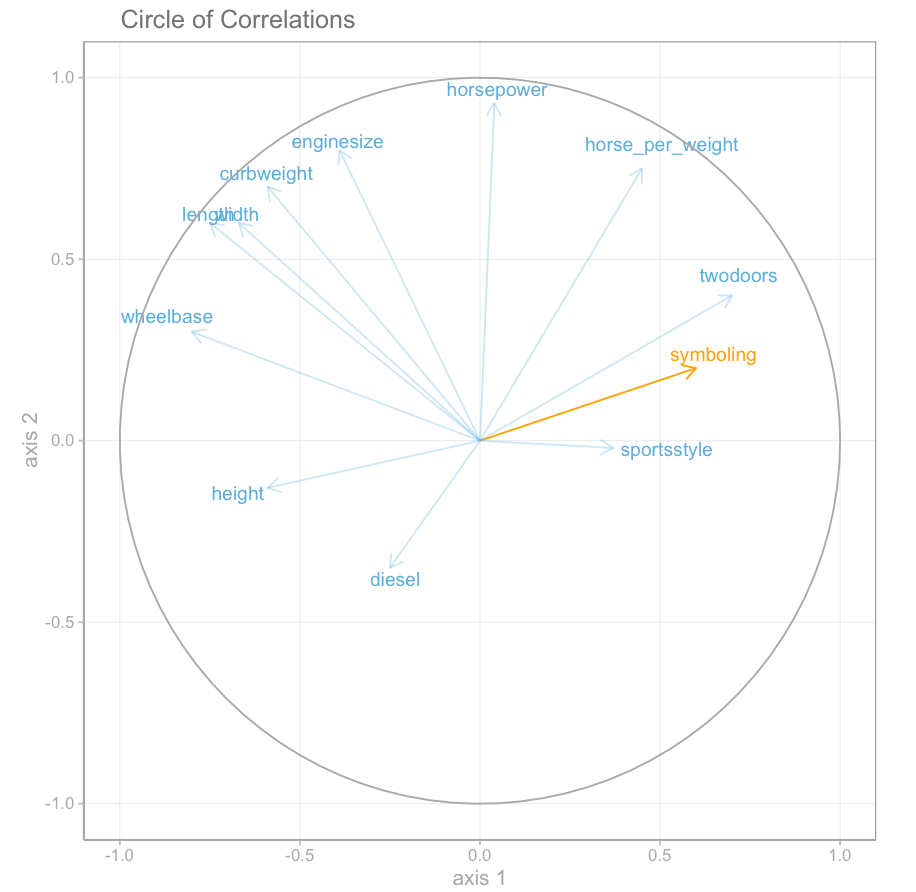Построить регрессионный биплот частичных наименьших квадратов с помощью ggplot2
С использованием data.frame ниже (Источник: http://eric.univ-lyon2.fr/~ricco/tanagra/fichiers/en_Tanagra_PLSR_Software_Comparison.pdf)
Данные
df <- read.table(text = c("
diesel twodoors sportsstyle wheelbase length width height curbweight enginesize horsepower horse_per_weight conscity price symboling
0 1 0 97 172 66 56 2209 109 85 0.0385 8.7 7975 2
0 0 0 100 177 66 54 2337 109 102 0.0436 9.8 13950 2
0 0 0 116 203 72 57 3740 234 155 0.0414 14.7 34184 -1
0 1 1 103 184 68 52 3016 171 161 0.0534 12.4 15998 3
0 0 0 101 177 65 54 2765 164 121 0.0438 11.2 21105 0
0 1 0 90 169 65 52 2756 194 207 0.0751 13.8 34028 3
1 0 0 105 175 66 54 2700 134 72 0.0267 7.6 18344 0
0 0 0 108 187 68 57 3020 120 97 0.0321 12.4 11900 0
0 0 1 94 157 64 51 1967 90 68 0.0346 7.6 6229 1
0 1 0 95 169 64 53 2265 98 112 0.0494 9.0 9298 1
1 0 0 96 166 64 53 2275 110 56 0.0246 6.9 7898 0
0 1 0 100 177 66 53 2507 136 110 0.0439 12.4 15250 2
0 1 1 94 157 64 51 1876 90 68 0.0362 6.4 5572 1
0 0 0 95 170 64 54 2024 97 69 0.0341 7.6 7349 1
0 1 1 95 171 66 52 2823 152 154 0.0546 12.4 16500 1
0 0 0 103 175 65 60 2535 122 88 0.0347 9.8 8921 -1
0 0 0 113 200 70 53 4066 258 176 0.0433 15.7 32250 0
0 0 0 95 165 64 55 1938 97 69 0.0356 7.6 6849 1
1 0 0 97 172 66 56 2319 97 68 0.0293 6.4 9495 2
0 0 0 97 172 66 56 2275 109 85 0.0374 8.7 8495 2"), header = T)
и это
Код
library(plsdepot)
df.plsdepot = plsreg1(df[, 1:11], df[, 14, drop = FALSE], comps = 3)
plot(df.plsdepot, comps = c(1, 2))
Я получил это
Результат
Зависимая (y) переменная здесь symboling, как и цена, является функцией всех других независимых переменных для автомобилей (diesel, twodoors, sportsstyle, wheelbase, length, width, height, curbweight, enginesize,horsepower, horse_per_weight)
Вопрос
Любая помощь в создании сюжета выше, используя ggplot2 а со стрелками вместо линий похожий на этот сюжет будет высоко оценен?
1 ответ
Решение
df <- read.table(text = c("
diesel twodoors sportsstyle wheelbase length width height curbweight enginesize horsepower horse_per_weight conscity price symboling
0 1 0 97 172 66 56 2209 109 85 0.0385 8.7 7975 2
0 0 0 100 177 66 54 2337 109 102 0.0436 9.8 13950 2
0 0 0 116 203 72 57 3740 234 155 0.0414 14.7 34184 -1
0 1 1 103 184 68 52 3016 171 161 0.0534 12.4 15998 3
0 0 0 101 177 65 54 2765 164 121 0.0438 11.2 21105 0
0 1 0 90 169 65 52 2756 194 207 0.0751 13.8 34028 3
1 0 0 105 175 66 54 2700 134 72 0.0267 7.6 18344 0
0 0 0 108 187 68 57 3020 120 97 0.0321 12.4 11900 0
0 0 1 94 157 64 51 1967 90 68 0.0346 7.6 6229 1
0 1 0 95 169 64 53 2265 98 112 0.0494 9.0 9298 1
1 0 0 96 166 64 53 2275 110 56 0.0246 6.9 7898 0
0 1 0 100 177 66 53 2507 136 110 0.0439 12.4 15250 2
0 1 1 94 157 64 51 1876 90 68 0.0362 6.4 5572 1
0 0 0 95 170 64 54 2024 97 69 0.0341 7.6 7349 1
0 1 1 95 171 66 52 2823 152 154 0.0546 12.4 16500 1
0 0 0 103 175 65 60 2535 122 88 0.0347 9.8 8921 -1
0 0 0 113 200 70 53 4066 258 176 0.0433 15.7 32250 0
0 0 0 95 165 64 55 1938 97 69 0.0356 7.6 6849 1
1 0 0 97 172 66 56 2319 97 68 0.0293 6.4 9495 2
0 0 0 97 172 66 56 2275 109 85 0.0374 8.7 8495 2"), header = T)
library(plsdepot)
library(ggplot2)
df.plsdepot = plsreg1(df[, 1:11], df[, 14, drop = FALSE], comps = 3)
data<-df.plsdepot$cor.xyt
data<-as.data.frame(data)
#Function to draw circle
circleFun <- function(center = c(0,0),diameter = 1, npoints = 100){
r = diameter / 2
tt <- seq(0,2*pi,length.out = npoints)
xx <- center[1] + r * cos(tt)
yy <- center[2] + r * sin(tt)
return(data.frame(x = xx, y = yy))
}
dat <- circleFun(c(0,0),2,npoints = 100)
ggplot(data=data, aes(t1,t2))+
ylab("")+xlab("")+ggtitle("Circle of Correlations ")+
theme_bw() +geom_text(aes(label=rownames(data),
colour=ifelse(rownames(data)!='symboling', 'orange','blue')))+
scale_color_manual(values=c("orange","#6baed6"))+
scale_x_continuous(breaks = c(-1,-0.5,0,0.5,1))+
scale_y_continuous(breaks = c(-1,-0.5,0,0.5,1))+
coord_fixed(ylim=c(-1, 1),xlim=c(-1, 1))+xlab("axis 1")+
ylab("axis 2")+ theme(axis.line.x = element_line(color="darkgrey"),
axis.line.y = element_line(color="darkgrey"))+
geom_path(data=dat,aes(x,y), colour = "darkgrey")+
theme(legend.title=element_blank())+
theme(axis.ticks = element_line(colour = "grey"))+
theme(axis.title = element_text(colour = "darkgrey"))+
theme(axis.text = element_text(color="darkgrey"))+
theme(legend.position='none')+
theme(plot.title = element_text(color="#737373")) +
theme(panel.grid.minor = element_blank()) +
annotate("segment",x=0, y=0, xend= 0.60, yend= 0.20, color="orange",
arrow=arrow(length=unit(0.3,"cm")))+
annotate("segment",x=0, y=0, xend= -0.25, yend= -0.35, color="#6baed6",
alpha=0.3,arrow=arrow(length=unit(0.3,"cm")))+
annotate("segment",x=0, y=0, xend= 0.45, yend= 0.75, color="#6baed6",
alpha=0.3,arrow=arrow(length=unit(0.3,"cm")))+
annotate("segment",x=0, y=0, xend= 0.37 , yend=-0.02, color="#6baed6",
alpha=0.3,arrow=arrow(length=unit(0.3,"cm")))+
annotate("segment",x=0, y=0, xend= -0.80, yend= 0.30, color="#6baed6",
alpha=0.3,arrow=arrow(length=unit(0.3,"cm")))+
annotate("segment",x=0, y=0, xend= -0.75, yend= 0.60, color="#6baed6",
alpha=0.3,arrow=arrow(length=unit(0.3,"cm")))+
annotate("segment",x=0, y=0, xend= -0.67, yend= 0.60, color="#6baed6",
alpha=0.3,arrow=arrow(length=unit(0.3,"cm")))+
annotate("segment",x=0, y=0, xend= -0.59, yend= -0.13, color="#6baed6",
alpha=0.3,arrow=arrow(length=unit(0.3,"cm")))+
annotate("segment",x=0, y=0, xend= -0.59, yend= 0.70, color="#6baed6",
alpha=0.3,arrow=arrow(length=unit(0.3,"cm")))+
annotate("segment",x=0, y=0, xend= -0.39, yend= 0.80, color="#6baed6",
alpha=0.3,arrow=arrow(length=unit(0.3,"cm")))+
annotate("segment",x=0, y=0, xend= 0.04, yend= 0.93, color="#6baed6",
alpha=0.3,arrow=arrow(length=unit(0.3,"cm")))+
annotate("segment",x=0, y=0, xend= 0.70, yend= 0.40, color="#6baed6",
alpha=0.3,arrow=arrow(length=unit(0.3,"cm")))

